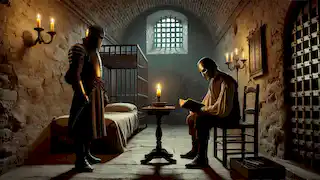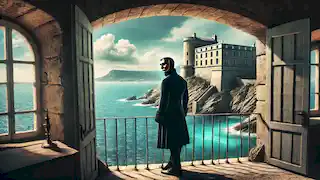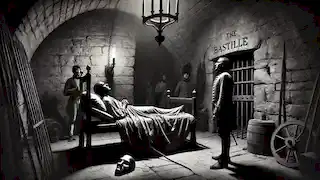Introduction
In the heart of France, among the grand intrigues of the royal court, one story has captured the imagination of historians and novelists alike—the mysterious tale of the Man in the Iron Mask. Who was this enigmatic prisoner, his identity hidden beneath a mask for years, locked away from the world in various fortresses under the watchful eyes of the French monarchy? Some say he was a royal twin, others a disgraced nobleman. The truth may never fully be known, but the legend continues to stir fascination and speculation. This story delves into the life and mystery surrounding this nameless man, exploring the dark corners of French history, ambition, and secrecy.
A Prisoner Is Taken
The summer of 1669 was one of scorching heat in France. In the bustling streets of Paris, gossip swirled around the king’s latest policies and the court’s extravagant expenditures, but there was one conversation that remained hidden in whispers—the imprisonment of a man whose identity no one seemed to know.
It began when a group of royal guards, dressed in the familiar blue and gold uniforms, quietly transferred a prisoner under the cover of night from the Bastille to a secluded fortress in Pignerol. The prisoner was said to be a man of considerable height, of striking presence, though no one could recall his face. He wore a mask of black iron, and not even his jailors were allowed to remove it. The king himself, Louis XIV, had decreed the mask was to remain on at all times.

Rumors began to spread in the high circles of Paris. Some speculated the man was a traitor, while others believed he was a fallen noble, cast aside for daring to challenge the Sun King. But the most sensational gossip claimed he was none other than Louis XIV’s own brother, an identical twin, hidden away since birth to prevent a struggle for the throne.
At the center of this intrigue was Bénigne Dauvergne de Saint-Mars, a trusted servant of the crown, charged with the man’s custody. Saint-Mars had a reputation as a fierce and loyal warden, a man who carried out his duties without question. He accompanied the masked man wherever he went, from fortress to fortress, guarding him as if the secret of the prisoner’s identity could topple the very foundations of France itself.
The Royal Secret
In the palace of Versailles, a world away from the grim reality of the masked prisoner’s life, Louis XIV basked in his court’s adoration. He was the Sun King, the ruler of one of the most powerful nations in Europe, and everything in his kingdom revolved around him. His grandeur was unmatched, and his vision of absolute monarchy left no room for dissent or challenge.
But within the gilded walls of Versailles, there were secrets. Deep secrets. And none more unsettling than the existence of a brother—an identical twin, no less—who had the same claim to the throne. It was said that their father, Louis XIII, had feared the possibility of two heirs, and had taken measures to ensure only one would rule. The second son, a boy who had the same regal blood, was removed from sight. His existence was hidden from all, even from Louis XIV himself, for many years.
When Louis XIV eventually discovered the truth, the revelation was so dangerous that he could not allow his brother to live as a free man. The resemblance between them was too strong, and any hint of a royal twin could destabilize the delicate balance of power that kept the French monarchy intact. So, the king made a fateful decision: his brother would be imprisoned for life, his face hidden beneath an iron mask, known only to a select few.
The man in the iron mask knew this was his fate. He had grown up in the shadows, taught to hide his true self, but there was still a spark of defiance within him. Though he was trapped in a cage of secrecy, his mind wandered freely, imagining a life he could have had—a life as king.
Pignerol and Saint-Mars
For years, the masked man was kept in the fortress of Pignerol, high in the Italian Alps. The fortress was remote, isolated, and nearly impossible to escape. The perfect place to hide someone whose very existence was a threat to the monarchy.

Saint-Mars was the warden of Pignerol, and his vigilance was unmatched. He was fiercely loyal to the king and carried out his orders with precision and cruelty. He and the masked man never spoke of the prisoner’s past, but over the years, a strange relationship developed between them. Saint-Mars treated the man with respect, though he maintained a strict discipline. He ensured the prisoner had books, comfortable quarters, and even fine food, but he never let the mask be removed.
Despite the physical comfort, the masked man was a prisoner in every sense of the word. His life was confined to the stone walls of the fortress, and the iron mask was a constant reminder of the life he could never have. The only connection to the outside world came in the form of letters Saint-Mars would occasionally read to him—news of the king’s triumphs, the opulence of the court, and the endless wars that France waged across Europe.
In those moments, the masked man felt a pang of bitterness. Though he was a prisoner, he had the blood of royalty running through his veins. He could have been the one celebrated in the courts of Europe, commanding armies, and basking in the glory that his brother now enjoyed.
The Mystery Deepens
The years passed, and the man in the iron mask was moved from fortress to fortress, each time under the careful watch of Saint-Mars. By 1687, he was transferred to the island of Sainte-Marguerite, off the coast of Cannes. The isolation of the island only deepened the mystery surrounding the prisoner.

Few ever saw the man, and those who did were sworn to secrecy under the threat of death. The mask never left his face, and speculation about his true identity grew wilder with each passing year. Some believed he was a foreign prince, held hostage to keep the peace between rival nations. Others thought he was a powerful noble who had crossed the king and paid the ultimate price. But the most persistent theory remained that of the royal twin—an identical brother, hidden away to preserve Louis XIV’s reign.
The few guards who were brave enough to speak of the prisoner described him as a man of intelligence and dignity, despite his circumstances. He was well-read and carried himself with the grace of a nobleman, even while wearing the iron mask. But the one thing they could not describe was his face, for it remained forever hidden.
The Final Years
In 1698, Saint-Mars and his mysterious prisoner were transferred to the Bastille, the infamous fortress in Paris where many political prisoners met their end. The move to the Bastille brought the masked man closer to the heart of the kingdom, but also closer to the end of his life.
The final years of the man in the iron mask were spent in near-total isolation. His identity remained a closely guarded secret, and even the officials of the Bastille were forbidden from speaking his name or attempting to learn more about him. He was simply known as "the man in the iron mask," and that was enough.
By 1703, the man’s health began to fail. He was no longer the robust figure he had once been. Age and the years of imprisonment had taken their toll, and the mystery of his life was nearing its conclusion. On November 19, 1703, the man in the iron mask died in his cell at the Bastille. His death was marked by little fanfare, and his body was buried in an unmarked grave, his name erased from history, his identity lost to time.
The Legacy of the Iron Mask
The story of the man in the iron mask did not end with his death. In fact, it was only the beginning. For centuries, writers, historians, and conspiracy theorists have tried to unravel the mystery of the masked prisoner’s true identity. Was he truly the brother of Louis XIV, locked away to prevent a challenge to the throne? Or was he someone else entirely, whose importance to the crown was so great that he could never be allowed to live freely?

The tale of the man in the iron mask has become a symbol of the dark secrets that lie at the heart of power. It is a reminder that even kings and queens, with all their wealth and power, have things they wish to keep hidden from the world. The mystery of the iron mask continues to captivate imaginations, and though the man’s face was never seen, his story has been etched into the annals of history.
Conclusion
To this day, the identity of the man in the iron mask remains one of the greatest unsolved mysteries in French history. His life, shrouded in secrecy, serves as a cautionary tale about the dangers of absolute power and the lengths to which those in power will go to protect their thrones. Whether he was a royal twin, a disgraced noble, or something else entirely, the man in the iron mask remains an enduring symbol of the hidden truths that lie just beneath the surface of history.



















